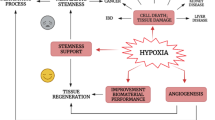Abstract
In this study, we examined the impact of 3-day hypoxia of different degrees on the viability, proliferation, and secretory activity of endothelial cells from human umbilical vein (HUVEC). A gas mixture of three components was used (%): 1) 10 O2, 5 CO2, and 85 Ar; 2) 5 O2, 5 CO2, and 80 Ar; and 3) 1 O2, 5 CO2, and 94 Ar. Cells cultivated in a CO2 incubator in atmospheric oxygen (21% O2) served as control. It was found that 3-day HUVEC cultivation at 1% O2 increased NO synthesis; enhanced secretion of endothelin-1, IL-6, IL-8, TNF-alpha, sVCAM-1, sE-cadherin, sE-selectin, VEGF-A, and bFGF; and inhibited proliferation. HUVEC cultivated under 10% O2 and 5% O2 exhibited the lowest level of basal secretion of these substances and increased proliferative activity. These cells cultivated under conditions of atmospheric oxygen for 3 days displayed activated secretion of NO, IL-6, IL-8, and von Willebrand factor; the activation was higher than at 10% O2 and 5% CO2. Thus, the gaseous medium with reduced oxygen content (5%) is a more physiological condition for HUVEC cultivation. An increase in the amount of oxygen up to the atmospheric level causes endotheliocyte activation; the cells exhibit the features of endothelial dysfunction. Oxygen content reduced to 1% induces endothelial dysfunction and reduced proliferative potential.
Similar content being viewed by others
Abbreviations
- bFGF:
-
basal fibroblast growth factor
- HUVEC:
-
human umbilical vein endothelial cells
- IL:
-
interleukin
- NO:
-
nitrogen oxide
- VEGF:
-
vascular endothelial growth factor
References
Antonova, O.A., Loktionova, S.A., Golubeva, N.V., Romanov, Yu.A., and Mazurov, A.V., Damage and activation of endothelial cells during in vitro hypoxia, Bull. Exp. Biol. Med., 2007, vol. 144, no. 10, pp. 384–386.
Antonova, O.A., Loktionova, S.A., Shustova, O.N., Golubeva, N.V., and Mazurov, A.V., Effects of hypoxia and reoxygenation on human cultured endothelial cells, Vest. Cardiol., 2009, vol. 4, no. 2, pp. 12–17.
Bresgen, N., Karlhuber, G., Krizbai, I., Bauer, H., Bauer, H.C., and Eck, P.M., Oxidative stress in cultured cerebral endothelial cells induces chromosomal aberrations, micronuclei, and apoptosis, J. Neurosc. Res., 2003, vol. 72, pp. 327–333.
Buravkova, L.B., Grinakovskaya, O.S., and Merzlikina, N.V., Effects of hyperoxic gas mixtures on the proliferative and migrative activities of cultivated endothelial cells of humans, Aviakosm. Ekol. Med., 2006, vol. 3, pp. 38–42.
Elchaninova, S.A., Korenyak, N.A., Dryagina, I.V., and Makarenko, V.V., Endothelial injury markers as a possible criterion for the efficiency of treatment for arterial hypertension, Klin. Lab. Diagn., 2007, vol. 2, pp. 40–42.
Efimenko, A.Yu., Starostina, E.E., Rubina, K.A., Kalinina, N.I., and Parfenova, E.V., Viability and angiogenic activity of mesenchymal stromal cells from adipose tissue and bone marrow under hypoxia and inflammation in vitro, Cell Tiss. Biol., 2010, vol. 4, pp. 117–127.
Fong, G.H., Mechanisms of adaptive angiogenesis to tissue hypoxia, J. Angiogenesis, 2008, vol. 11, pp. 121–140.
Forsythe, J.A., Jiang, B.H., Iyer, N.V., Agani, F., Leung, S.W., and Koos, R.D., and Semenza, G.L., Activation of vascular endothelial growth factor gene transcription by hypoxia-inducible factor 1, Mol. Cell. Biol., 1996, vol. 16, pp. 4604–4613.
Hickey, M.M. and Simon, M.C., Regulation of angiogenesis by hypoxia and hypoxia-inducible factors, Curr. Top. Dev. Biol., 2006, vol. 76, pp. 217–257.
Jaffe, E.A., Nachman, R.L., Becker, G.C., and Ninick, C.R., Culture of human endothelial cells derived from umbilical veins, J. Clin. Invest., 1973, vol. 52, pp. 2745–2756.
Krasilnikova, E.I., Nifontov, E.M., Sergee-va, E.G., Antonova, T.V., Zhloba, A.A., Galki-na, O.V., and Romanova, M.A., Adhesion endothelial dysfunction and immune inflammatory factors in hypertensive patients with coronary heart disease: effects of rosuvastatin, Arter. Hypertenz., 2009, vol. 15, no. 3, pp. 268–274.
Lupinskaya, Z.A., Zariphyjan, A.G., Gurovich, T.Z., and Shleipher, S.G., Endotelii: funktsiya i disfunktsiya (Endothelium: Function and Dysfunction), Bishkek: KRSU, 2008.
Natarajan, R., Fisher, B.J., and Fowler, A.A., Regulation of hypoxia inducible factor-1 by nitric oxide in contrast to hypoxia in microvascular endothelium, FEBS Lett., 2003, vol. 549, pp. 99–104.
Pisarghevskiy, S.A., The endothelial permeability and atherosclerosis, Kardiologia, 2005, vol. 12, pp. 27–42.
Polyakova, A.P., Blinov, M.N., Kargin, V.D., and Kapustin, S.I., Molecular mechanisms of endothelial dysfunction in venous thromboembolism: the present state and perspectives of investigation, Transfuziologiya, 2011, vol. 12, pp. 1248–1265.
Popova, L.A. and Vaizova, O.E., Modern view of vascular endothelium in terms of general system theory, Fundam. Issled., 2012, vol. 2, no. 2, pp. 328–332.
Rassaf, T., Feelisch, M., and Kelm, M., Circulating NO pool assessment of nitrite and nitrosospecies in blood and tissues, Free. Rad. Biol. Med., 2004, vol. 36, pp. 413–422.
Shushlyapin, O.I., Kononenko, L.G., and Ìànik, I.M., Von Willebrand factor and its role in endothelial dysfunction in ischemic heart disease: diagnostics, criteria of prognosis and perspective treatment approaches, Ukr. Kardiol. Zh., 2006, vol. 3, pp. 126–131.
Solodovnikova, I.M., Saprunova, V.B., Bakeeva, L.E., and Yaguijinsky, L.S., Dynamics of mitochondrial ultrastructure in small pieces of cardiac tissue under long-term anoxic incubation, Tsitologiia, 2006, vol. 48, no. 10, pp. 848–855.
Starikova, E.A., Lebedeva, A.M., Burova, L.A., and Freidlin, I.S., Alteration in the endothelial cell functional activity by the Streptoccocus pyogenes ultrasonic lysate, Cell Tiss. Biol., 2012, vol. 6, pp. 154–161.
Urazovskaya, I.L., Vinogradova, D.A., Skripnik, D.V., and Vasiljeva, E.Yu., Endothelial dysfunction in patients with acute coronary syndrome, Kreativ. Kardiol., 2009, vol. 1, pp. 50–54.
Ziegelstein, R.C., He, C., and Hu, Q., Hypoxia/reoxygenation stimulates Ca2+-dependent ICAM-1 mRNA expression in human aortic endothelial cells, Biochem. Biophys. Res. Commun., 2003, vol. 322, pp. 68–73.
Author information
Authors and Affiliations
Corresponding author
Additional information
Original Russian Text © L.V. Antonova, V.G. Matveeva, M.N. Chernova, E.A. Velikanova, A.V. Ponasenko, A.S. Golovkin, 2014, published in Tsitologiya, 2014, Vol. 56, No. 1, pp. 67–76.
Rights and permissions
About this article
Cite this article
Antonova, L.V., Matveeva, V.G., Chernova, M.N. et al. Proliferative and secretory activity of human umbilical endothelial cells cultivated under various hypoxia conditions. Cell Tiss. Biol. 8, 204–212 (2014). https://doi.org/10.1134/S1990519X14030031
Received:
Published:
Issue Date:
DOI: https://doi.org/10.1134/S1990519X14030031




